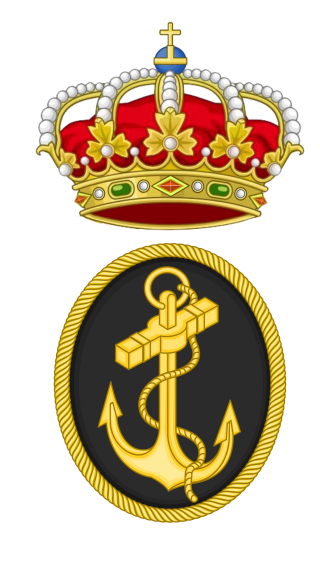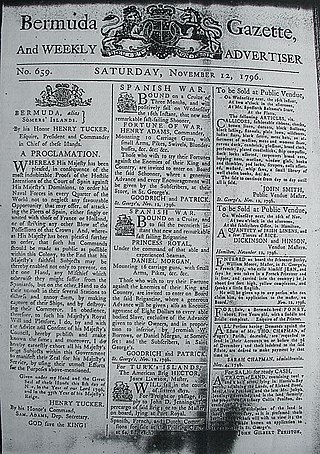Related Research Articles

The history of the Mediterranean region and of the cultures and people of the Mediterranean Basin is important for understanding the origin and development of the Mesopotamian, Egyptian, Canaanite, Phoenician, Hebrew, Carthaginian, Minoan, Greek, Persian, Illyrian, Thracian, Etruscan, Iberian, Roman, Byzantine, Bulgarian, Arab, Berber, Ottoman, Christian and Islamic cultures. The Mediterranean Sea was the central superhighway of transport, trade and cultural exchange between diverse peoples encompassing three continents: Western Asia, North Africa, and Southern Europe.

The Anglo–Dutch Wars were a series of conflicts mainly fought between the Dutch Republic and England in the mid-17th and late 18th century. The first three wars occurred in the second half of the 17th century over trade and overseas colonies, while the fourth was fought a century later. Almost all the battles were naval engagements.

The Spanish Navy or officially, the Armada, is the maritime branch of the Spanish Armed Forces and one of the oldest active naval forces in the world. The Spanish Navy was responsible for a number of major historic achievements in navigation, the most famous being the discovery of America and the first global circumnavigation. For several centuries, it played a crucial logistical role in the expansion and consolidation of the Spanish Empire, and defended a vast trade network across the Atlantic Ocean between the Americas and Europe, and the Manila Galleon across the Pacific Ocean between the Philippines and the Americas.
Naval warfare is combat in and on the sea, the ocean, or any other battlespace involving a major body of water such as a large lake or wide river.

The Imperial Japanese Navy was the navy of the Empire of Japan from 1868 to 1945, when it was dissolved following Japan's surrender in World War II. The Japan Maritime Self-Defense Force (JMSDF) was formed between 1952 and 1954 after the dissolution of the IJN.
A thalassocracy or thalattocracy, sometimes also maritime empire, is a state with primarily maritime realms, an empire at sea, or a seaborne empire. Traditional thalassocracies seldom dominate interiors, even in their home territories. Examples of this were the Phoenician states of Tyre, Sidon and Carthage; the Italian maritime republics of Venice and Genoa of the Mediterranean; the Chola Empire of Tamil Nadu in India; the Omani Empire of Arabia; and the empires of Srivijaya and Majapahit in Maritime Southeast Asia. Thalassocracies can thus be distinguished from traditional empires, where a state's territories, though possibly linked principally or solely by the sea lanes, generally extend into mainland interiors in a tellurocracy.

Commerce raiding is a form of naval warfare used to destroy or disrupt logistics of the enemy on the open sea by attacking its merchant shipping, rather than engaging its combatants or enforcing a blockade against them.

The Prussian Navy, officially the Royal Prussian Navy, was the naval force of the Kingdom of Prussia from 1701 to 1867.

A galley was a type of ship which relied mostly on oars for propulsion that was used for warfare, trade, and piracy mostly in the seas surrounding Europe. It developed in the Mediterranean world during antiquity and continued to exist in various forms until the early 19th century. It typically had a long, slender hull, shallow draft, and often a low freeboard. Most types of galleys also had sails that could be used in favourable winds, but they relied primarily on oars to move independently of winds and currents. The term "galley" originated from a Greek term for a small type of galley and came in use in English from about 1300. It has occasionally been used for unrelated vessels with similar military functions as galley but which were not Mediterranean in origin, such as medieval Scandinavian longships, 16th-century Acehnese ghalis and 18th-century North American gunboats.

Naval warfare in World War I was mainly characterised by blockade. The Allied Powers, with their larger fleets and surrounding position, largely succeeded in their blockade of Germany and the other Central Powers, whilst the efforts of the Central Powers to break that blockade, or to establish an effective counter blockade with submarines and commerce raiders, were eventually unsuccessful. Major fleet actions were extremely rare and proved less decisive.
Naval strategy is the planning and conduct of war at sea, the naval equivalent of military strategy on land.

Maritime history is the study of human interaction with and activity at sea. It covers a broad thematic element of history that often uses a global approach, although national and regional histories remain predominant. As an academic subject, it often crosses the boundaries of standard disciplines, focusing on understanding humankind's various relationships to the oceans, seas, and major waterways of the globe. Nautical history records and interprets past events involving ships, shipping, navigation, and seafarers.

The Maritime history of Europe represents the era of recorded human interaction with the sea in the northwestern region of Eurasia in areas that include shipping and shipbuilding, shipwrecks, naval battles, and military installations and lighthouses constructed to protect or aid navigation and the development of Europe. Europe is situated between several navigable seas and intersected by navigable rivers running into them in a way which greatly facilitated the influence of maritime traffic and commerce. Great battles have been fought in the seas off of Europe that changed the course of history forever, including the Battle of Salamis in the Mediterranean, the Battle of Gravelines at the eastern end of the English Channel in the summer of 1588, in which the “Invincible” Spanish Armada was defeated, the Battle of Jutland in World War I, and World War II’s U-boat war.

The Influence of Sea Power upon History: 1660–1783 is a history of naval warfare published in 1890 by the American naval officer and historian Alfred Thayer Mahan. It details the role of sea power during the seventeenth and eighteenth centuries, and discussed the various factors needed to support and achieve sea power, with emphasis on having the largest and most powerful fleet. Scholars considered it the single most influential book in naval strategy. Its policies were quickly adopted by most major navies, ultimately leading to the World War I naval arms race. It is also cited as one of the contributing factors of the United States becoming a great power. It was followed by The Influence of Sea Power upon the French Revolution and Empire, 1793–1812, published in 1892.

The Ottoman Navy or The Imperial Navy, also known as the Ottoman Fleet, was the naval warfare arm of the Ottoman Empire. It was established after the Ottomans first reached the sea in 1323 by capturing Praenetos, the site of the first Ottoman naval shipyard and the nucleus of the future navy.

Mare Nostrum was a Roman name for the Mediterranean Sea. In Classical Latin, it would have been pronounced, and in Ecclesiastical Latin, it is pronounced.

Greece is a maritime nation by tradition, as shipping is arguably the oldest form of occupation of the Greeks and has been a key element of Greek economic activity since ancient times. Today, shipping is the country's most important industry worth $21.9 billion in 2018. If related businesses are added, the figure jumps to $23.7 billion, employs about 392,000 people, and shipping receipts are about 1/3 of the nation's trade deficit. In 2018, the Greek Merchant Navy controlled the world's largest merchant fleet, in terms of tonnage, with a total DWT of 834,649,089 tons and a fleet of 5,626 Greek-owned vessels, according to Lloyd's List. Greece is also ranked in the top for all kinds of ships, including first for tankers and bulk carriers.
Ancient navies had a large impact on the navies of today. The outcomes of battles between ancient navies have been studied by the military to learn tactics that would help in their conquests. The ships that these civilizations created were what many ship designs were based on and allowed the vessels to become better built. The Punic Wars are some of the most notorious wars in history, and the naval vessels and tactics used in all three became a major part of naval military history.

The Venetian navy was the navy of the Venetian Republic which played an important role in the history of the republic and the Mediterranean world. It was the premier navy in the Mediterranean Sea for many centuries between the medieval and early modern periods, providing Venice with control and influence over trade and politics far in excess of the republic's size and population. It was one of the first navies to mount gunpowder weapons aboard ships, and through an organised system of naval dockyards, armouries and chandlers was able to continually keep ships at sea and rapidly replace losses. The Venetian Arsenal was one of the greatest concentrations of industrial capacity prior to the Industrial Revolution and responsible for the bulk of the republic's naval power.

The Genoese navy was the naval contingent of the Republic of Genoa's military. From the 11th century onward the Genoese navy protected the interests of the republic and projected its power throughout the Mediterranean and Black Seas. It played a crucial role in the history of the republic as a thalassocracy and a maritime trading power.
References
- ↑ Børresen 1994, p. 148.
- ↑ "Stephen Biddle on Strategy in the Western Pacific". The Maritime Executive. Retrieved 5 April 2017.
- ↑ "Can Israel become a maritime power?". The Times of Israel. Retrieved 4 April 2017.
- ↑ David Sanders; David Patrick Houghton (2016). Losing an Empire, Finding a Role: British Foreign Policy Since 1945. Macmillan International Higher Education. p. 32. ISBN 978-1137447135.
- ↑ Couperus (1993), p.32
- ↑ "Venice - History". Encyclopedia Britannica. Retrieved 2021-09-18.
- ↑ "Genoa | Geography, History, Facts, & Points of Interest". Encyclopedia Britannica. Retrieved 2021-09-18.
- ↑
- Grant, Jonathan A. Rulers, Guns, and Money: The Global Arms Trade in the Age of Imperialism. Cambridge, MA: Harvard University Press, 2007. ISBN 0-674-02442-7. OCLC 166262725.
 , pp. 121–23.
, pp. 121–23.
- Grant, Jonathan A. Rulers, Guns, and Money: The Global Arms Trade in the Age of Imperialism. Cambridge, MA: Harvard University Press, 2007. ISBN 0-674-02442-7. OCLC 166262725.
- ↑ Scheina, Robert. Latin America: A Naval History 1810–1987. Annapolis: Naval Institute Press, 1987, pp. 43–46.
- ↑ William Sater, Chile and the United States: Empires in Conflict, 1990 by the University of Georgia Press, ISBN 0-8203-1249-5
- ↑ Evans, David & Peattie, Mark R. (1997). Kaigun: Strategy, Tactics, and Technology in the Imperial Japanese Navy, 1887–1941. Annapolis, Maryland: Naval Institute Press. ISBN 0-87021-192-7.
- ↑ "Who rules the waves?". The Economist. Retrieved 4 April 2017.
- ↑ "G20 | Homepage". www.g20.org. Archived from the original on 31 March 2017. Retrieved 5 April 2017.
- ↑ "G8 Information Centre". www.g8.utoronto.ca. Retrieved 5 April 2017.
- ↑ "JOINT SITE OF MINISTRIES OF FOREIGN AFFAIRS OF BRICS MEMBER STATES". infobrics.org. Archived from the original on 22 March 2017. Retrieved 5 April 2017.